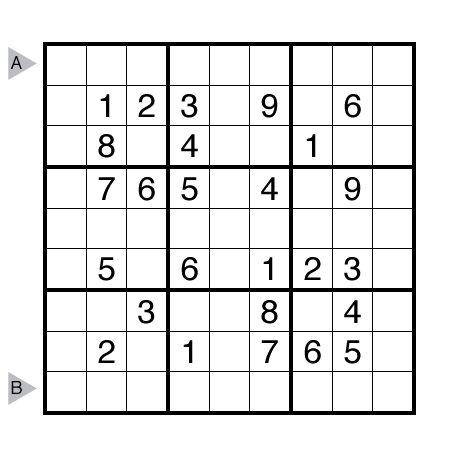Sudoku by Thomas Snyder

or solve online (using our beta test of Penpa-Edit tools)
Theme: X’s and O’s (Originally for 2014 Arlington Puzzle Festival)
Author/Opus: This is the 208th puzzle from Thomas Snyder, aka Dr. Sudoku.
Rules: Standard Sudoku rules.
Answer String: Enter the 1st row from left to right, followed by a comma, followed by the 9th row from left to right.
Time Standards (highlight to view): Grandmaster = 2:15, Master = 3:45, Expert = 7:30
Solution: PDF
Note: Follow this link for other classic Sudoku. If you are new to this puzzle type, here are our easiest Sudoku to get started on. More classic Sudoku puzzles can be found in The Art of Sudoku, The Art of Sudoku 2 and in our beginner-friendly collection Intro to GMPuzzles by Serkan Yürekli.

2:56.A delightful sudoku!
20:27
I’m still not sure why I struggle with sudoku so much. It’s a puzzle type that I’ve never found much fun, (my opinion was probably tainted by so many poor sudoku puzzles out there—some of the variations that I’ve first encountered here on gmpuzzles are definitely interesting).
And I don’t know if it’s that I’m so bad at seeing the logic that makes solving seem tedious to me. Or if it’s because it seems tedious that I don’t practice much and don’t get better.
I think part of the problem for me is that the nature of the different constraints is all the same. With other puzzle types it’s really satisfying to switch back and forth between a local constraint (say, a shape constraint such as in LITS or a pentomino puzzle), and a global constraint like connectivity. Obviously, sudoku does have different constraints, but since they’re all just “one of each number” sometimes the whole thing feels like bookkeeping.
But again, that might be because I’ve somehow adopted a mechanical approach. I’m sure I would enjoy it more if I could learn to “just see” things rather than marching around randomly to different cells, evaluating all of the constraints for each cell.
Anyway, I apologize if that all sounds like complaining. What is interesting to me is how drastically performance can vary from puzzle type to puzzle type. I’ve noticed that skynet and I often post comparable times across a wide range of puzzle types. But not today!
Carl — You’re not the only one who feels that way. I’ve always said that (standard) sudoku is a visual recognition challenge disguised as a logic puzzle. It feels like a completely different kind of solve compared to other puzzles on this site (and elsewhere).
That’s a bit of a strange thing to say in my opinion. All logic puzzles essential reduce to visual recognition challenges! It all depends on how well you can translate the clues as given into solving intuition.
As with all logic puzzles, every part of the puzzle you solve leads to more information that will help you solve another part of the puzzle, but the beauty of sudoku is that this linear aspect of puzzle solving can be subtly and beautifully disguised. One of the flaws with sudoku is that they can be made impossibly hard with much interconnected logic that you have to take into account all at once. The difference with most hand made puzzles (such as the ones found here) is that the author will always have made sure there are “meta-clues” which point you in the right direction. For example, something like box reduction or pointing pairs is very rarely seen by coincidence – if you identify it then there is a very good chance you will need to use it directly, as opposed to being a small part of something much more complicated.
A good analogy is solving a word-search, in that you can by-pass that subtlety by brute forcing the solve (bookkeeping, if you will) – but then if you are going to solve like that it’s hard to argue against every solve feeling the same.
I haven’t the faintest idea what you mean by “point you in the right direction”. But the analogy to word search is apt. Both cases need more visual processing skill than typical logical puzzles. You need to visualize and absorb the entire grid without a clue as to which part of the grid your next step might be. In other puzzles, the eyeball can focus on a much smaller area (what Carl W calls a “local constraint”) and take several steps at a time before having to scan the grid for the next promising lead.